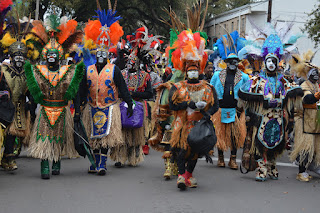New Orleans
culture, tradition and architecture are steeped in religious influences. In this blog, Kole and I will introduce you
to some of those religious influences while discussing how they created the
unique fabric of what has been referred by some as the most exotic city in the
world.
Among the first, and to this day, the most prominent religion associated with New Orleans is Roman Catholicism. Jean Baptiste Le Moyne de Bienville, a French colonist and the first governor of Louisiana founded the city. During that time, the only recognized religion was Roman Catholicism. He not only established the city, but decided on it's layout and design. This included the first Catholic Church, St. Louis Catholic Church, which would eventually become St. Louis Cathedral-Basilica that stands in the city's central focal point, Jackson Square. (ADDED) Throughout our blog we will highlight on some of New Orleans key religious influences. We will talk about famous religious elements of New Orleans such as Marie Laveau, New Orleans Voodoo, Roman Catholicism, Southern Baptism, and historical landmarks such as the St. Louis Cathedral. While walking through the city of New Orleans there are religious landmarks located all over that you wouldn't necessarily recognize unless you knew what you were looking for. The goal of this blog is to increase your knowledge on the historical significance that religion has had on New Orleans.
At the time of the city's founding and in the years to come, New Orleans was among the most prominent ports of entry in the New World. This meant that people from around the world came to New Orleans for a variety of reasons. Trade, immigration, and to escape tyranny or hardships abroad.
New Orleans was also the key point of entry for the slave trade which brought in African culture and religious influences. A revolution in Haiti resulted in vast immigration to the city. They brought their own version of African influenced religious beliefs and culture. These two influences of African culture and religion brought what is known as Voodoo to New Orleans. A belief that spirits and long passed ancestors have daily interaction with our lives blended European religious beliefs and culture to create one uniquely New Orleans, a culture separate and distinct from any other in the world.
One result of this blending is known the world over as Mardi Gras. Originally a French celebration in anticipation of the upcoming season of Lent known "Boeuf Gras," or fatted calf. Bienvillle and his men celebrated in an area between the mouth of the Mississippi River and New Orleans which he named "Pointe du Mardi Gras". Eventually, the celebration of Mardi Gras became a New Orleans tradition. The blending of Native American, African, Hatian, and European cultural traditions with the celebration evolved into the anual festive celebration that we know today.
Among the first, and to this day, the most prominent religion associated with New Orleans is Roman Catholicism. Jean Baptiste Le Moyne de Bienville, a French colonist and the first governor of Louisiana founded the city. During that time, the only recognized religion was Roman Catholicism. He not only established the city, but decided on it's layout and design. This included the first Catholic Church, St. Louis Catholic Church, which would eventually become St. Louis Cathedral-Basilica that stands in the city's central focal point, Jackson Square. (ADDED) Throughout our blog we will highlight on some of New Orleans key religious influences. We will talk about famous religious elements of New Orleans such as Marie Laveau, New Orleans Voodoo, Roman Catholicism, Southern Baptism, and historical landmarks such as the St. Louis Cathedral. While walking through the city of New Orleans there are religious landmarks located all over that you wouldn't necessarily recognize unless you knew what you were looking for. The goal of this blog is to increase your knowledge on the historical significance that religion has had on New Orleans.
Zulu Parade
You will see that New Orleans’ culture, tradition, and religion are
inseparable. Not only are New Orleans’
religious roots historically significant, but the ever evolving spiritual and
non-spiritual elements of religion are blending the past to the future. We look forward to sharing with you. Just keep an open mind and remember religious
beliefs are unique to each person and community.




